How to Make Rose Harissa Paste
Rose harissa is a fragrant red pepper paste with rose water common in Maghrebi cuisine. Culinary uses for this sweet, fiery, fragrant paste with its distinctive floral hum are endless!
If you enjoy cooking with Middle Eastern flavours – or own any Yotam Ottolenghi cookbooks – you’ve likely encountered rose harissa paste in an ingredient list. But, depending on your location, rose harissa may be tricky to track down.
Luckily, it is easy to make rose harissa from scratch! And, there is something so rewarding about making your own rose harissa paste.
Your whole house smells of toasted spices after you cook the homemade rose harissa down into a sweet, fiery paste. All before you stir in just the right amount of rose water and petals for that subtle floral hint of rose harissa paste, and adjust the spiciness to your preference.
Sounds perfect, right?
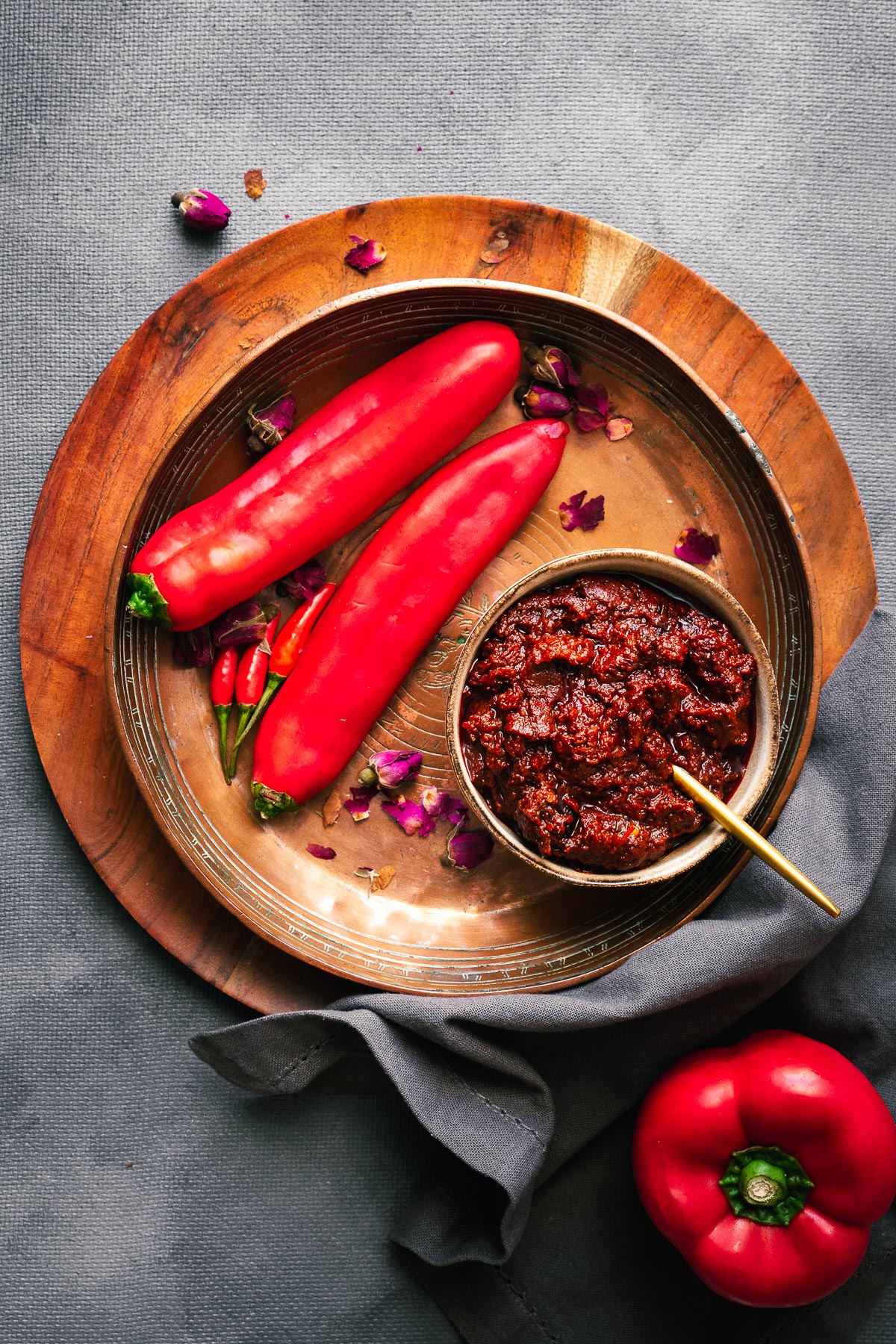
What is rose harissa paste?
Rose harissa is a hot pepper paste used in Middle Eastern and North African cuisine. The main ingredients are peppers, spices, garlic, olive oil, and rose petals or rose water.
It is a fiery and fragrant red pepper paste with the subtle floral hum of rose water. It adds depth to any soup, stew or even salad.
Olive oil preserves the paste and carries the oil-soluble flavours.
Rose harissa vs harissa paste
Harissa paste and rose harissa paste are both made from red peppers (dried or fresh), spices, garlic and olive oil that gets ground into an aromatic, flavorful paste. Rose harissa paste also has rose water or rose petals giving it a slight floral hum.
Learn more about different types of harissa paste and how to use it.
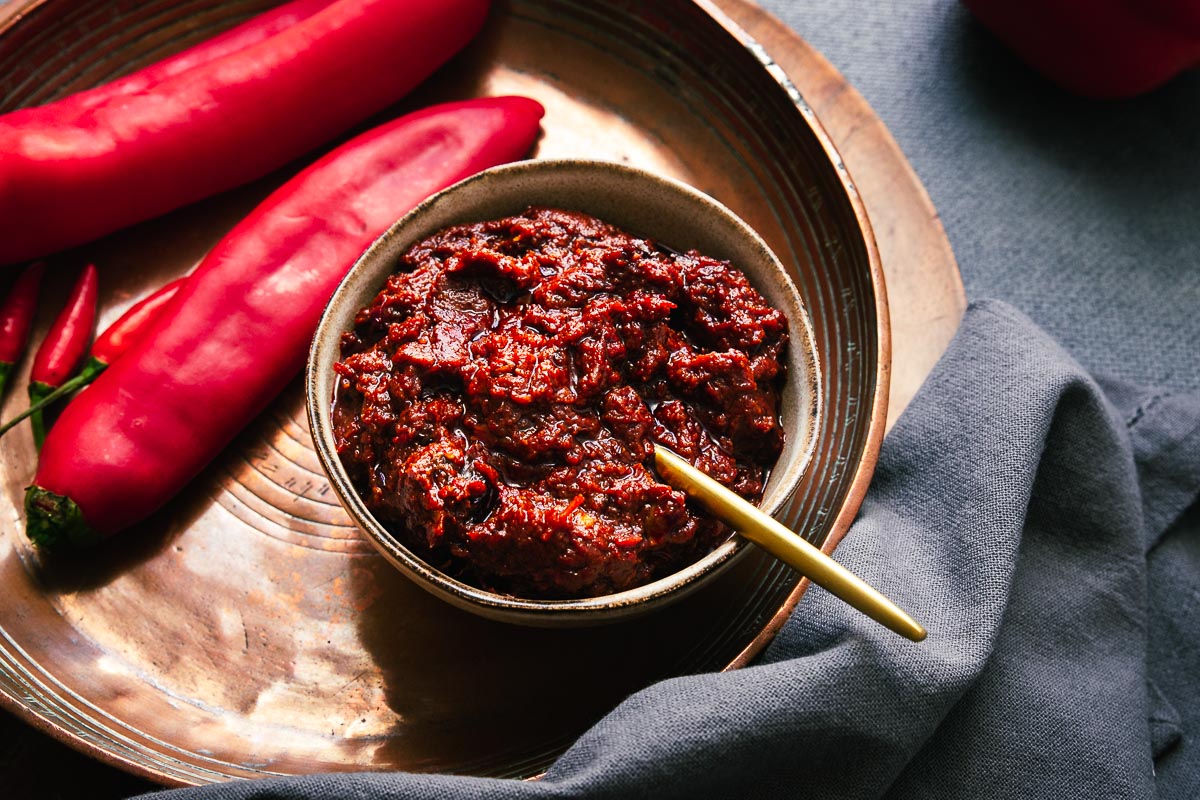
Why you’ll love this rose harissa recipe
I’ve been making my own harissa paste for years, trying out different methods in the process. This method of making rose harissa paste is adapted from Casablanca: My Moroccan Food by Nargisse Benkabbou.
She distinguishes between plain, fragrant and rose harissa. And makes use of fresh red peppers (some spicy chillies and some sweet bell peppers) to cook it down into the most fragrant red pepper paste.
Over time, her guidelines evolved into this, my ultimate rose harissa paste recipe.
And I think you will love it too! Mostly because when you make harissa paste at home, you can adapt the flavours to suit your palate:
- Love the spicy stuff as much as I do? Layer your chillies by adding fresh, dried and even fermented chillies to the paste.
- Don’t cope too well with chilli heat? Use a mild dose of Kashmiri powder instead or even omit it in favour of paprika. I know, I know. Is it even harissa if it’s not spicy? Probably not. But you do you!
As an added bonus, this rose harissa recipe is naturally plant-based, dairy-free and gluten-free.
Ingredients
Lucky for us rose harissa ingredients are all simple and easy to come by. The recipe is also very flexible, so feel free to swap ingredients to your heart’s content.
- Garlic cloves: You can add raw garlic cloves to the food processor, or roast them with the red peppers for a deeper flavour.
- Red peppers: Traditional rose harissa is made from Tunisian baklouti peppers, but you can use roasted red bell peppers (homemade or jarred) for the base.
- Chilli peppers: I like to use a combination of rehydrated dried chilli peppers (like ancho peppers) and fresh spicy red peppers (like Thai bird’s chillies and serrano peppers). But you can stick to one type and adjust it to suit your spice preference. Or skip the chillies for a non-spicy rose harissa paste.
- Spice mix: My favourite harissa spice mix consists of cumin, fennel, coriander and caraway seeds. But you don’t need to use all four. Just use the ones you have. And if you want a smoky flavour, you can stir in some smoked paprika too!
- Lemon juice: Fresh lemon juice adds balance in flavour and acidity for longevity.
- Extra virgin olive oil: It carries the soluble flavours of the harissa and keeps it fresher for longer.
- Rose: I use both rose petals and rose water, but you can use either.
- Salt: Use kosher salt or sea salt to balance the flavour.
How to make rose harissa paste
Make your own rose harissa paste in four basic steps:
- Prepare your red peppers (or buy jarred roasted peppers) and chilli peppers.
- Flavour it with toasted spices and rose water.
- Blend everything into a smooth harissa sauce.
- Cook the sauce slowly to reduce it into harissa paste.
Step 1: Prepare the peppers
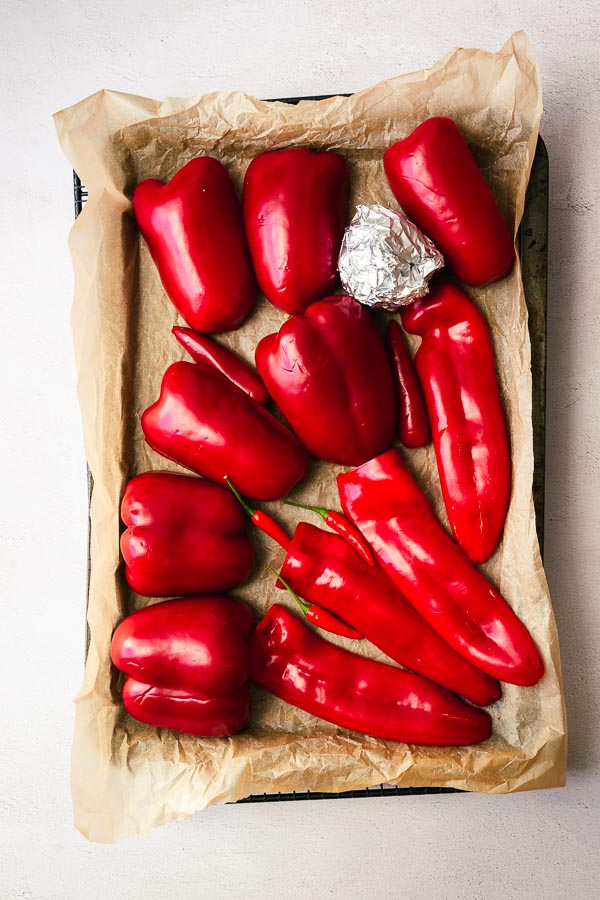
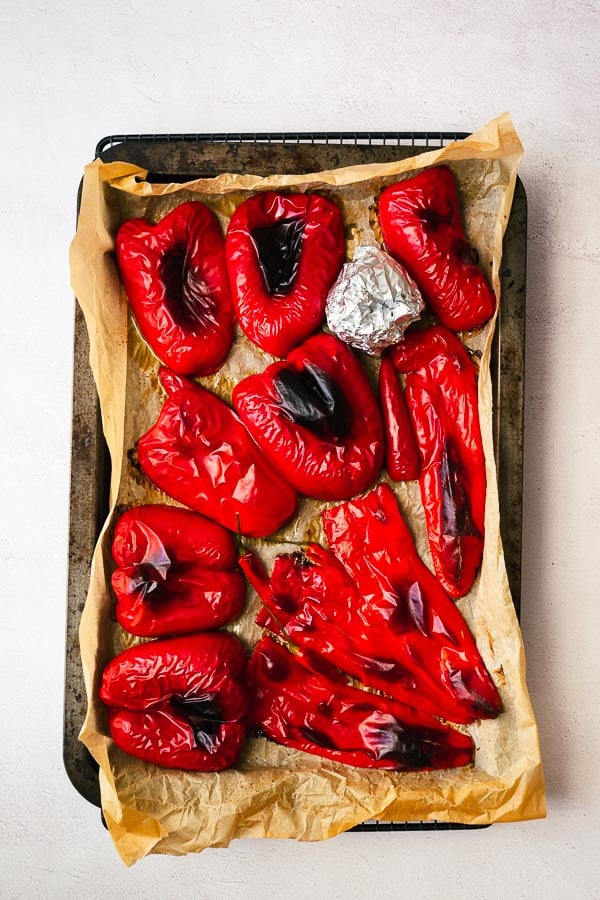
Remove the veins, seeds and membranes from the sweet red peppers. I like to keep my fresh chillies whole. Roast everything in a hot oven.
Tip: I like to add a whole foil-wrapped garlic bulb to roast with the peppers for a sweeter flavour.
Once the peppers are wrinkled and slightly charred, remove them from the oven and leave until cool enough to handle before peeling the charred skin.
Tip: Or you can use jarred roasted red peppers to save time.
Rehydrate your dried chillies in hot water – if using. I love dried ancho chillies for their smoky flavour. But if you are in no mood to rehydrate dried chillies, skip them and stick to fresh red chillies.
Feel free to experiment here! You can also drastically reduce the spiciness by sticking to a mild chilli powder like Kashmiri.
Step 2: Flavour your paste with toasted spices, garlic and rose
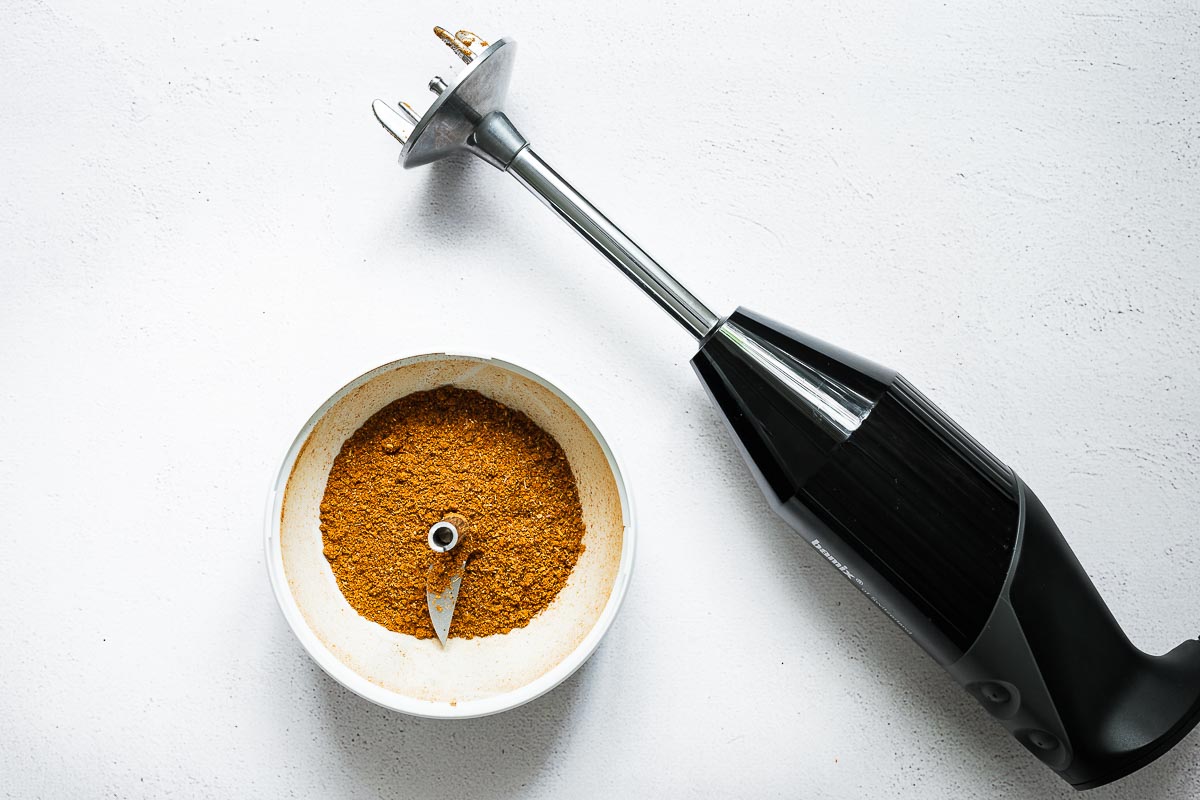
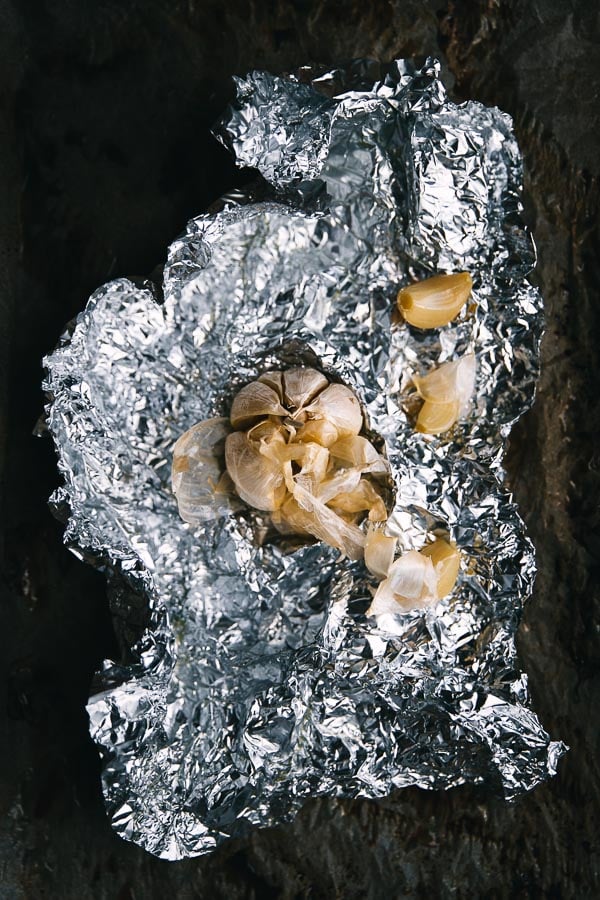
I love a rose harissa spice blend of cumin, fennel, coriander, and caraway seeds. If you don’t have all of these, use more of the spices you do have.
Tip: As soon as you grind spices, they start to lose their flavour. Spices toasted whole in a pan – and ground just before using – are the most fragrant. But if you don’t have a spice grinder, you can simply use pre-ground spices instead.
In the same way, roasting the garlic (with the peppers) makes it sweeter and a bit more mellow. But it’s not traditional, so feel free to add raw garlic cloves to the food processor instead – stick to around 6 raw, peeled cloves.
Step 3: Blend the sauce
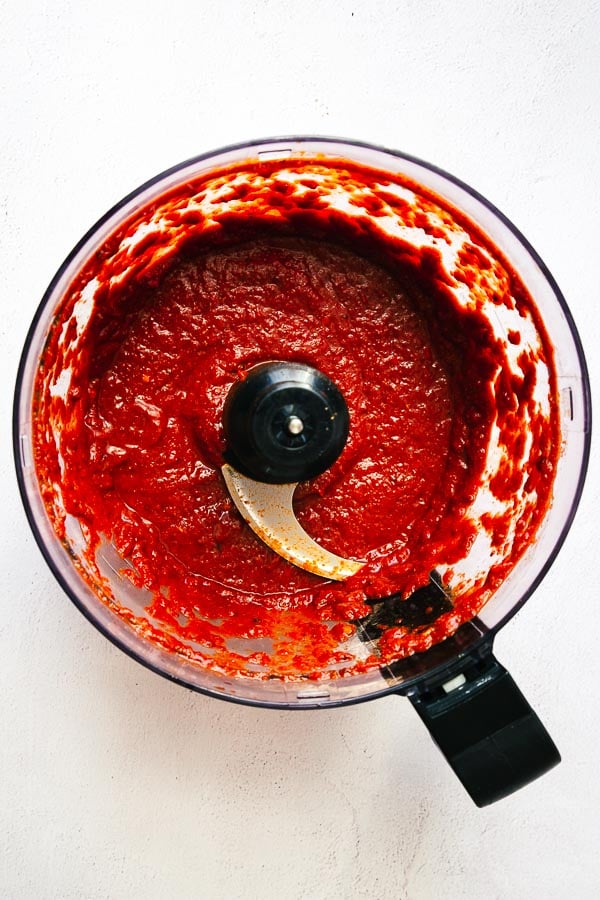
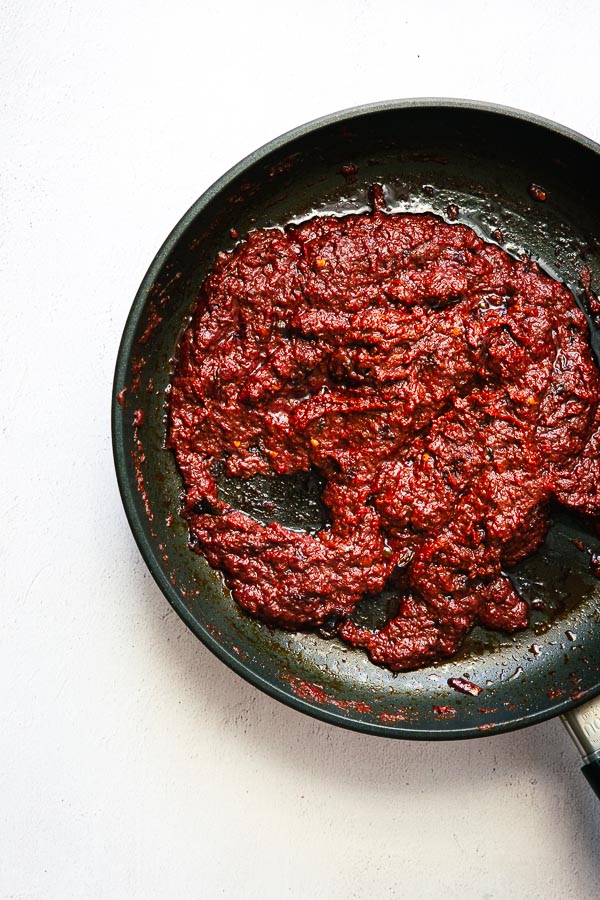
Blitz the peeled peppers, chilli peppers, spices, roast garlic (or raw garlic) and lemon juice together in a food processor to form a sauce. You may need to scrape the sides down as you go.
Step 4: Cook the harissa sauce into a thick paste
You can use the rose harissa sauce once blended. The flavours will be fiery and fragrant already. But the magic happens when you cook the sauce down into a paste.
There should be no water remaining, and the oil will start to seep out of the paste.
This rose harissa paste recipe yields a complex, sweet, fragrant and fiery paste with distinct red pepper and rosey harissa notes – approximately 1½ cups worth.
If this all sounds like too much effort, I also have a super easy recipe for harissa paste made simply by rehydrating dried peppers.
Storage
Transfer the paste to a sterilised jar and cover it with olive oil. The olive oil helps to preserve the paste.
Whenever you scoop out some harissa, top the remaining harissa up with more olive oil to keep the paste covered. Store the sealed container in the fridge for up to a month.
When there is no more paste left in the jar – just bright red olive oil – use it for a fragrant harissa dressing, or for cooking. Harissa-oil fried eggs, anyone?
You can also freeze the paste in an ice cube tray for quick pops of flavour.
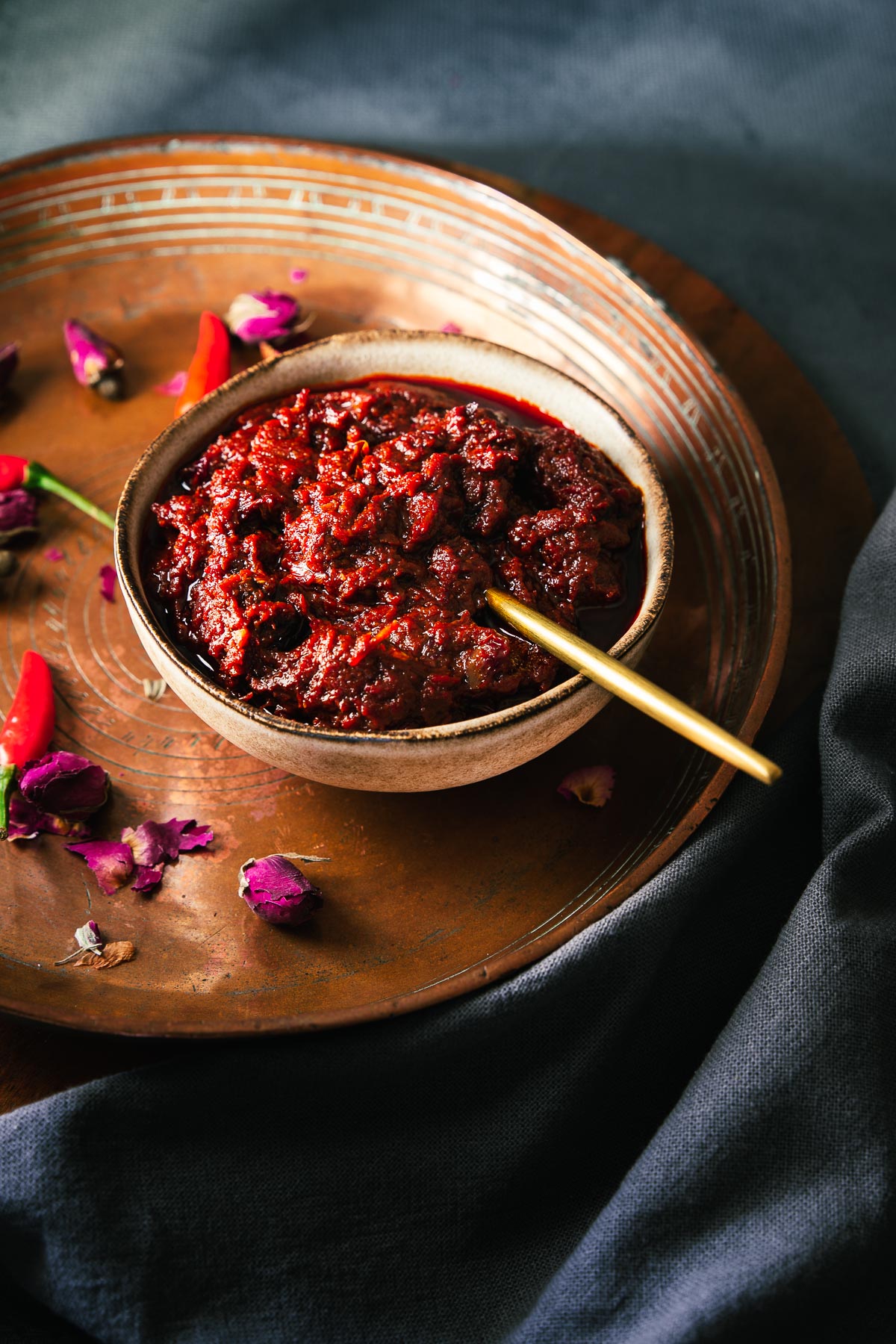
How to use rose harissa
Rose harissa is my favourite type of chilli paste. And for good reason. It’s such a versatile condiment!
It loves roasted vegetables:
Spread rose harissa over flatbreads and grill in the oven — mix the harissa paste with tomato paste for a milder version. Enjoy warm with a drizzle of extra virgin olive oil and flaky salt for a satisfying snack.
It adds depth to soups and stews for quick weeknight dinners:
- Moroccan-inspired harissa red lentil soup with cilantro salsa
It adds loads of flavour to quick condiments and salad dressings:
See more harissa recipes.
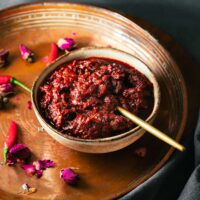
Equipment
- Spice grinder (optional)
Ingredients
- 6 garlic cloves , a whole bulb if roasting
- 2.2 pounds red peppers , about 5 large bell peppers
- 4 red chilli peppers* , adjust to taste
- 2 dried ancho chillies (optional) , or more to taste
- 1 tablespoon cumin seeds
- 1 tablespoon fennel seeds
- 1 tablespoon coriander seeds
- 1 tablespoon caraway seeds
- 1 tablespoon lemon juice
- 5 tablespoons extra virgin olive oil , and more for storing
- 2 tablespoons dried rose petals
- 2 tablespoons rose water , or a teaspoon of rose water concentrate
- 1 teaspoon salt
Instructions
- Preheat the oven to 430 °F. Reduce the heat accordingly if using a fan oven.
- Take a whole garlic bulb – or select 6 large cloves – and remove some of the loose skins. But do not unpeel it all the way. Rub with olive oil and wrap it in foil.
- Cut the red peppers in half. Remove and discard the cores, veins and seeds. Then place the peppers skin-side up on a sheet pan lined with parchment paper. Add the foil-covered garlic.
- Leave any small chillies whole for roasting. Cut large chillies in half if you want to scrape out the seeds and membranes for a milder harissa paste – or roast them whole too. Add the chillies to the sheet pan.
- Place the sheet pan in the hot oven for 15 minutes. Remove any small chillies – if using – and rotate the tray before returning it to the oven. Roast until the red pepper skin is wrinkly and charred in places – about 10 to 15 minutes more.
- If you are using dried ancho chillies, remove the stems and shake out the seeds. Then add them to a heatproof bowl and completely cover them with boiling water. Leave for 20 minutes to rehydrate. Roughly chop the flesh and set aside until needed.
- Once roasted, pile the peppers on a plate and cover with an upside-down heatproof mixing bowl, or use cling film. You want them to steam a little while they cool down so that the skins are easier to peel off. Leave aside until cool enough to handle.
- Place a large pan on medium-high heat and, once hot, toast the spices until fragrant and popping – about 3 minutes. Shake the pan from time to time for even toasting. Tip the toasted spices into a spice grinder and blitz until ground – or use a mortar and pestle.
- Once the roasted peppers are cool enough to handle, remove their skins. Most of the skin should come off without effort. You can leave the small stubborn pieces. Open the foil parcel – be mindful of steam when hot – and pop out the garlic cloves. They won’t be completely soft, but they will already be sweeter. If you roasted a whole garlic bulb, pick 6 large garlic cloves and store the rest in the fridge for quick weeknight flavour boosters. Or – if you are feeling particularly garlicky – use all the cloves.
- Roughly chop the garlic, peeled peppers and chillies. Add them to a food processor with the rehydrated chillies, spices and a tablespoon of lemon juice. Blitz everything together into a coarse paste, scraping down the sides if needed.
- Place 5 tablespoons of olive oil in the large pan you used for toasting spices. Add the red pepper mixture from the food processor and place the pan on medium heat. Add the rose petals and half of the rose water. Stir until the paste and oil are combined and bring to a simmer. Reduce the heat to medium-low and simmer, uncovered. Cook for 30 to 40 minutes, stirring occasionally. The paste is ready once the mixture is darker and there is no more liquid from the peppers, only the wonderfully flavoured red oil seeping from the paste. Add 1 teaspoon of salt and the remaining rose water. Taste and season with more salt if necessary. Don’t be alarmed, the spiciness will subside a touch once it cools down!
- Transfer the paste to a sterilised glass jar and cover it with olive oil. Refrigerate for up to a month. You can also freeze the paste in an ice cube tray for quick pops of flavour.
Notes
- You can use any sweet red peppers for the harissa base. I add various peppers from the market, but you can use plain red bell peppers only.
- You can also use jarred roasted peppers (about 20 ounces / 600 grams drained weight) and skip the roasting step. Just toast the garlic cloves and chillies in the pan with the spices.
- I roast an entire garlic bulb. If the bulb is small, I add all of it to the paste. And, if it is large, I use the remaining roasted garlic flesh in quick weeknight meals. But you can also roast the 6 garlic cloves on their own.
- If you don’t have all of the different spices required, use more of those that you do have. You still want 4 tablespoons of mixed spices to 2.2 pounds (1 kilogram) of fresh red peppers.
- If you don’t have a spice grinder or a mortar and pestle to grind the spices, substitute with pre-ground spices.
- I use a mix of fresh and dried chillies. Typically, I add 2 small bird’s eye chillies and 2 medium-hot serenade chillies, as well as 2 rehydrated dried ancho chillies for that smoky complexity. You can adjust the ratio of fresh to dried chillies. However, if you are adding more than 6 hot chillies, things start to get spicy!
- Rose water is available in a variety of strengths. If you are using a concentrate, like Nielsen Massey, try 2 teaspoons in total. If using a milder version like the Lebanese brand I typically use, you can go up to 2 (or even 3) tablespoons according to your taste. Remember, you can always add more rose water later – even when cooking with the paste.
- See recipes with rose harissa paste for your next dinner idea!
Love Middle Eastern Cooking?
If you enjoyed making your own rose harissa paste, you may want to try more of my favourite Middle Eastern condiments!

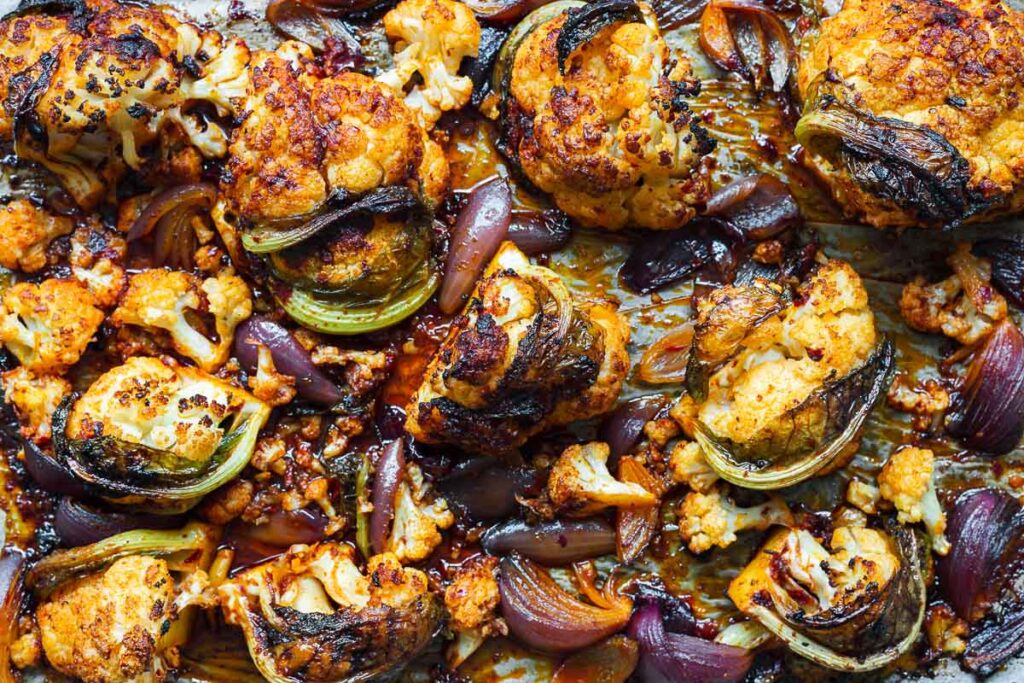
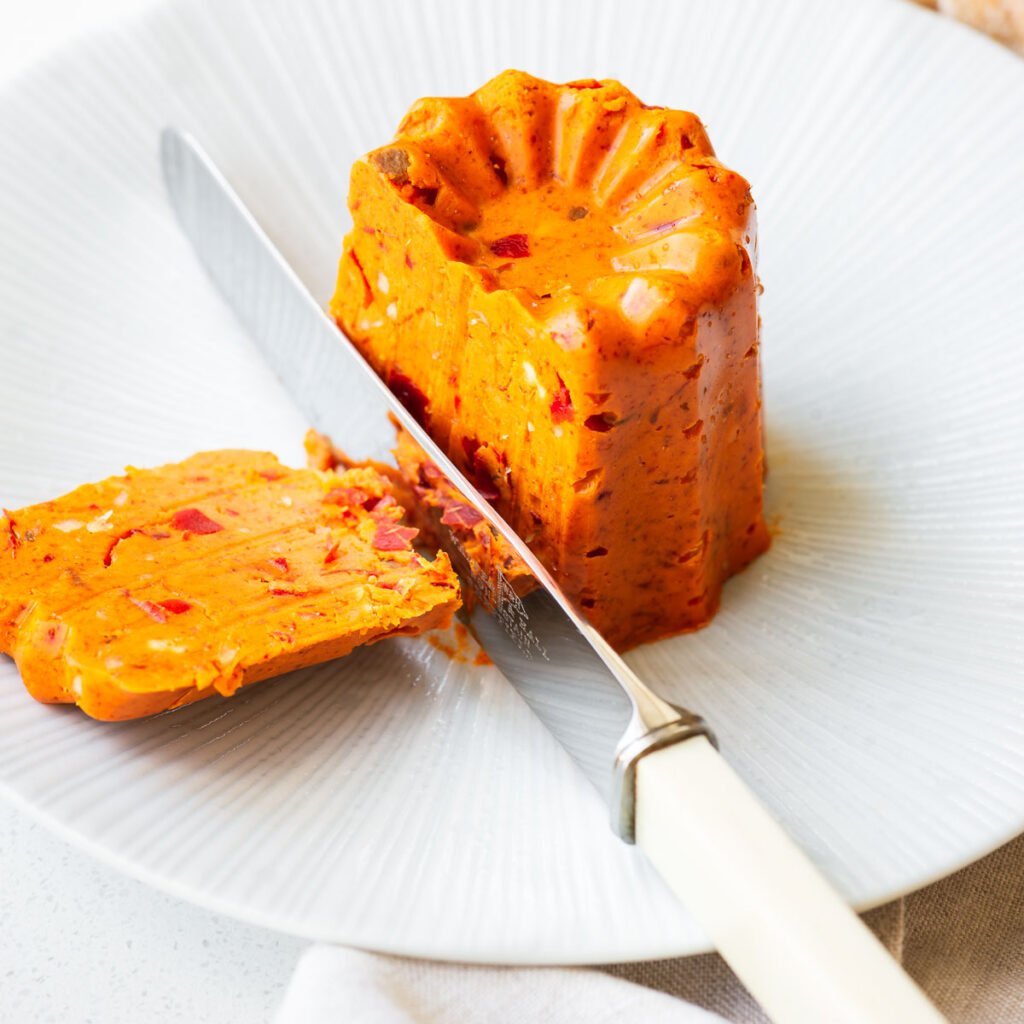


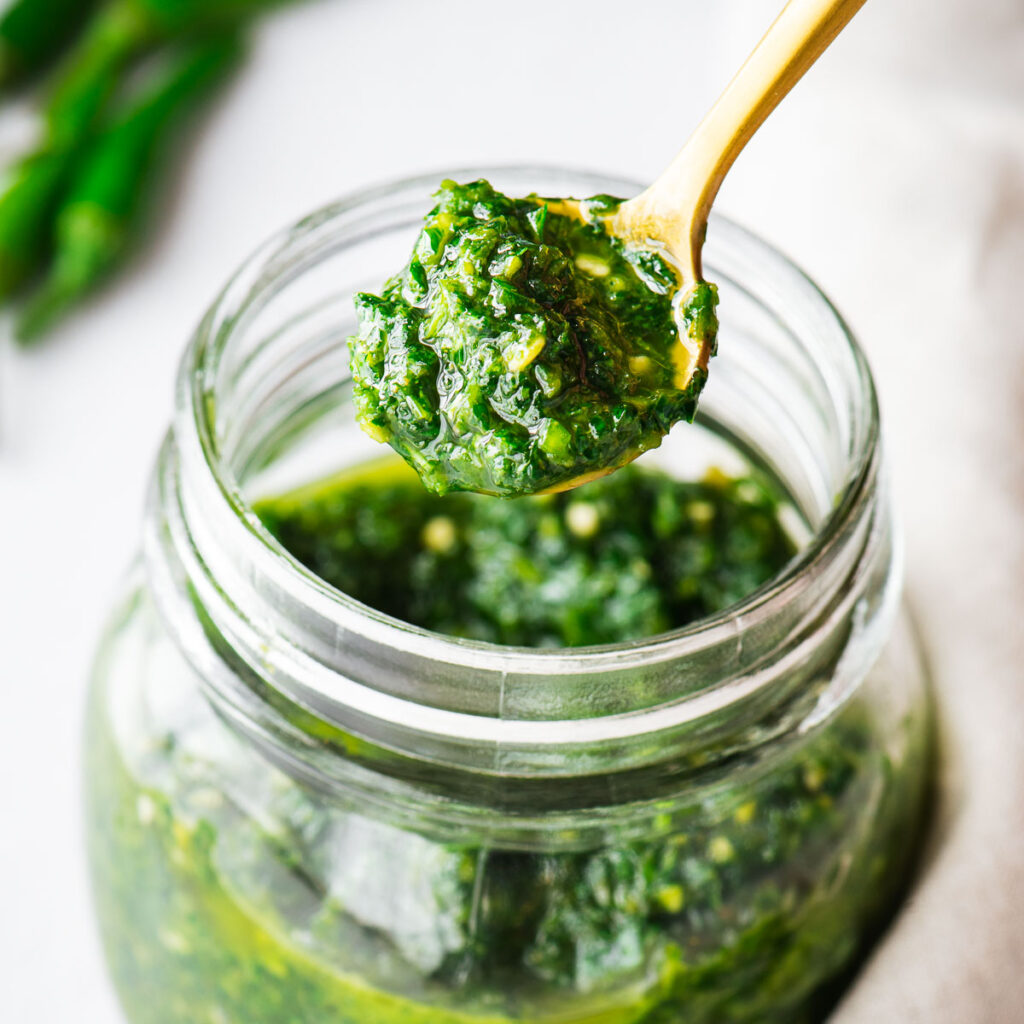



Wow…this is one wonderful recipe! Spectacular flavour
I’m so happy you enjoyed it, Lubna!
WOW! This rose harissa is so delicious. I can’t wait to make it again!
I’m so happy you loved it, Kushi! I add it to everything! 😂
I love recipes that call for harissa, but I’m not always able to find it in grocery stores. Now I don’t have to worry about that because I can make my own. Thanks for the great recipe!
I also adore recipes with harissa, Ashley! Don’t think I even remember how to cook without it. 😂
This was incredible and I now want to use it in everything and put it on everything. So good.
Yay! I’m so happy you loved it, Dannii! It really is sooo good on just about everything!
Scrambled eggs with harissa. ….amazing
Yeeeesss! So good! But honestly, I love rose harissa on almost anything. :-D
i love this recipe as i always like to have harrissa in the fridge. I use it for making merguez sausages and sausage rolls, as a coating for roast lamb, in salad dressings and marinades for meats and roasting veg and my favourite is to add it to mayonaise with honey and a little lime juice for an amazing dip for anything ESPECIALLY fresh made skinny fries. Just a kitchen essential. Thank you
I couldn’t agree more! Harissa is absolutely a kitchen essential.
I’m definitely making your sweet harissa mayo dip, it sounds perfect for just about EVERYTHING!
My favourite harissa! Taking the extra time to cook everything down into a paste is so worth it.
Thank you so much, Olive! ❤️ I couldn’t agree more! Cooking down the sauce intensifies the flavour like crazy.
Absolutely impressed! A taste sensation.
Thank you so much, Christine! ❤️❤️❤️
This is so delicious!
Thank you, Sarah! ❤️